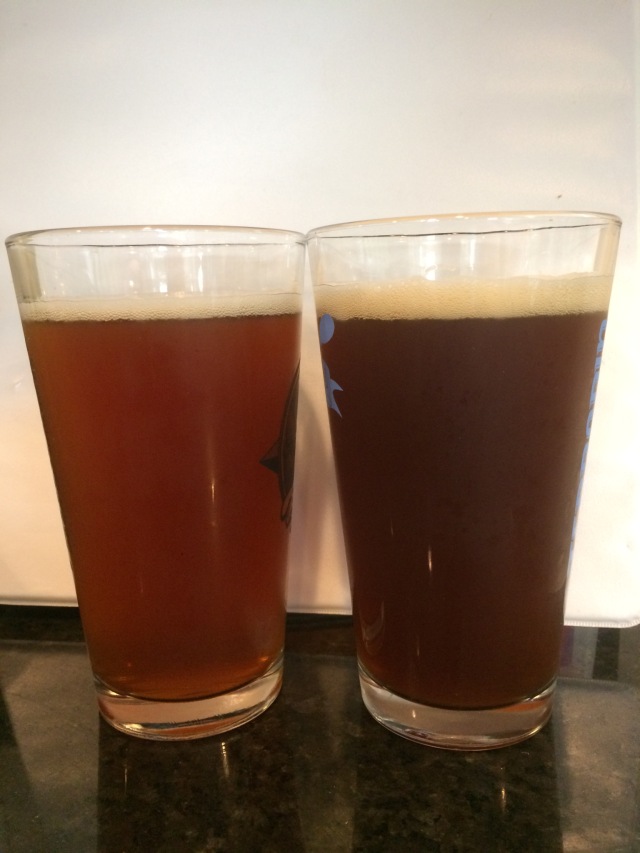This post is one in a series of making small adjustments to a single recipe in order to improve it, learn more about the impact each ingredient has on the finished product, and the art of recipe creation. The rest of the comparison tastings in this series can be found here.
The first brew of this series was not the beer I remembered it to be. The third beer is this series was a step in the wrong direction. In an effort to maintain perspective, though, I still wanted to directly compare these two. Even in failures, progress can still be measured if it is, in fact, being made. I’m a firm believer that failure is part of the learning process. Being wrong is often the first step towards being right, assuming that one does indeed critically examine that failure and determine its cause. Therefore, I poured two failures into a couple pint glasses and tasted the bitterness of defeat—or hops. It was probably just the hops.
As I have said before, I understand that the age difference in these beers is a factor here and that this is not as effective an exercise as it would be if I had brewed these beers on the same day and then tasted them side by side. However, that does not prevent me from being able to learn from them or see progress (assuming progress is actually there).
Recap
The full recipes of Iteration 1 and Iteration 3 of this red IPA can be found in the links. The main differences between these beers, though, were these:
- Iteration 1 used 1 lb. of C80
- Iteration 3 used 0.75 lbs. of C120 and 0.5 lbs. of Special B.
- Iteration 3 used 0.25 lbs. more grain total.
Both beers were fairly close in OG, with Iteration 1 being three gravity points higher. Both finished at the same FG of 1.008, meaning Iteration 1 was 0.4% higher in ABV. Outside of these differences, the beers were treated the same in terms of mash temperature, fermentation temperature, hopping schedule, and dry hopping routine.
Appearance
Both beers had a medium head and good head retention. (This confirms my suspicion that when I tasted beers 1 & 2 side by side, the bottle containing Iteration 1 was probably not properly sealed).
Iteration 3 was certainly more of the red ale color that I have been aiming for, compared to the copper color of Iteration 1. Looking at them beside one another, if they had been presented to me unknowingly, I would have assumed the first beer to be a pale ale. A little dark for a pale ale, yes, but certainly not a red ale.

Left: Iteration 1|Right: Iteration 3
Aroma
The aroma of beer 1 was lacking in hop character (to be expected because of age). There was a strong presence of caramel, though. Iteration 3 had notes of citrus and plum in the nose. Based on aroma and appearance, so far Iteration 3 was adding up to be less of a failure than I thought. It certainly had characteristics that I wanted it to have.
Flavor
Not only did the color of Iteration 1 remind me of a pale ale, but the flavor did too. Actually, I thought this would have made for a pretty decent pale ale with a couple small tweaks. The flavor was one of caramel with a bitterness in the finish. I also tasted some floral notes in the finish, but they were faint. Overall, the level of bitterness in this beer is good. I think, though, that that’s a factor of the balance of bitterness more than the level of bitterness.
Iteration 3 had a definite richness and fullness to it that was lacking in the first beer. It also had more mouthfeel than beer 1, but it still managed to come across as light. I’ll chalk that up to more malt complexity coupled with an FG of 1.008. Notes of citrus and plum were present, but there was also raisin in the mix. The finish was one of floral bitterness.
Final Thoughts
Even though it isn’t exactly where I want it to be, I still feel as though Iteration 3 is a better beer than 1—at least in terms of what I’m striving for. I may tweak the first beer to make a pale ale sometime in the future, but for a red IPA, number 3 is closer to my end goal. Despite the raisin flavor that clashes with the citrus hops (courtesy of the Special B), I still feel as though I’m closer to my desired malt profile than I was the first time.
Curious to see if landing somewhere in the middle of these beers would improve any aspect, I blended the remaining beer after finishing my initial notes. The resulting color was still very red, looking almost the same as Iteration 3 before the blending. Unfortunately, that was the only interesting surprise. The blend of these beers accentuated the caramel sweetness of beer 1 and tasted somewhere between a hoppy brown and a sweet amber ale. Although on paper that looks very much like it should taste like a hoppy red, it did not. I stand by my description because instead of a harmonious melding of flavors, the flavor seemed a confusing and muddled mix. The blend seemed to accentuate the negative aspects of each instead of bringing out the best in both. That said, I think this confirms that I’m headed in the right direction and that a compromise between these two beers is a compromise I should not make.
